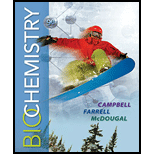
Concept explainers
RECALL Which reaction or reactions that we have met in this chapter require ATP? Which reaction or reactions produce ATP? List the enzymes that catalyze the reactions that require and that produce ATP.
Interpretation:
The reactions that require and produce
Concept introduction:
Glycolysis is a metabolic pathway that converts one molecule of glucose into two molecules of pyruvate.
Glycolysis is an anaerobic process that occurs in the absence of oxygen.
Glycolysis is the fundamental system of sugar metabolism in the body that contributes to the production of energy in the form of
Answer to Problem 1RE
Solution: The first step of glycolysis, which is the phosphorylation of glucose to glucose-
The step involving the phosphorylation of
Explanation of Solution
The phosphorylation of glucose to glucose-
The step where
Glycolysis results in the production of two molecules of
Want to see more full solutions like this?
Chapter 17 Solutions
Biochemistry
- RECALL Can the thermodynamic property G be used to predict the speed of a reaction in a living organism? Why or why not?arrow_forwardRECALL Are all enzymes proteins?arrow_forwardRECALL Define substrate-level phosphorylation and give an example from the reactions discussed in this chapter.arrow_forward
- REFLECT AND APPLY Why is it somewhat misleading to study bio- chemical pathways separately?arrow_forwardRECALL Show graphically how the reaction velocity depends on the enzyme concentration. Can a reaction be saturated with enzyme?arrow_forwardREFLECT AND APPLY In Section 2-4, we said that at the equivalence point of a titration of acetic acid, essentially all the acid has been converted to acetate ion. Why do we not say that all the acetic acid has been converted to acetate ion?arrow_forward
- RECALL Why is it necessary to define a modified standard state for biochemical applications of thermodynamics?arrow_forwardRECALL What is a suicide substrate? Why are they important?arrow_forwardREFLECT AND APPLY List two classes of compounds derived from arachidonic acid. Suggest some reasons for the amount of biomedical research devoted to these compounds.arrow_forward
 BiochemistryBiochemistryISBN:9781305961135Author:Mary K. Campbell, Shawn O. Farrell, Owen M. McDougalPublisher:Cengage Learning
BiochemistryBiochemistryISBN:9781305961135Author:Mary K. Campbell, Shawn O. Farrell, Owen M. McDougalPublisher:Cengage Learning
